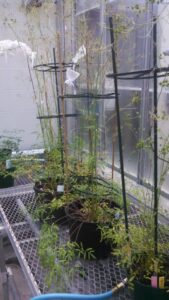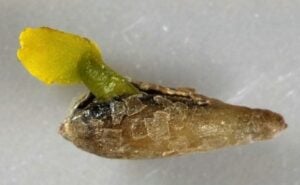December 17, 2014
The Road to an URCA Award
By: Erika Dietrick, Honors College Junior
 Applying for the ECU Undergraduate Research and Creative Achievement (URCA) award was similar to every other “first” I have had as a student new to research—confusing, overwhelming, and in the end, extremely rewarding.
Applying for the ECU Undergraduate Research and Creative Achievement (URCA) award was similar to every other “first” I have had as a student new to research—confusing, overwhelming, and in the end, extremely rewarding.
I began my research on the endangered plant species Thalictrum cooleyi Ahles, or Cooley’s meadowrue, this fall after a semester of volunteering in the laboratory. Volunteering consisted of learning laboratory protocol, listening to and participating in group meetings, gaining familiarity with commonly used equipment, and assisting in any hands-on or data-related tasks that needed to be completed. It was difficult to be at ease at times in the laboratory because I started with almost zero knowledge of plants, but I had been interested in Dr. Claudia Jolls’ lab because she was a patient, helpful, and effective instructor in the Honors Research Colloquium.
By the end of that semester, I had signed up for Field Botany and Plant Biology for the fall, sketched out a rough plan for my Senior Honors Project, and agreed to work as a Field Assistant for graduate student Renee Fortner. Suddenly, my life was plants, and I had no idea what I was in for.
Working in the pine savannas of Pender and Onslow counties is what solidified my confidence and interest. Every week or so, Renee and I would make the 2-hour drive to the site of Cooley’s meadowrue to gather information on sex ratios, pollination limitation, and density. With each trip, I gained a newfound appreciation for the species and the protection of the pine savanna ecosystem in general. There were so many memories made, from accidentally shattering a window of the biology truck to touching a venus fly trap for the first time. The savannas were gorgeous and made working in the blazing heat of a North Carolina summer worth it.
Despite the experience gained up to that point, this semester in the laboratory was still very much a challenge. I quickly realized how much thought, care, and work went into a quality research project. There are things professors will tell you in your required lab courses, such as keep a detailed lab notebook or read and plan the experimental procedures ahead of time, that you think aren’t a necessity. I couldn’t have been more wrong! It’s the attention to detail (along with several other admirable qualities) that make answering such significant scientific questions possible.
In addition to learning through experience what I should have learned the first time, I was also encouraged to apply for an URCA award by Dr. Jolls. (Follow link for more info.) Through many revisions, I attempted to convey in very few words the essence of my project: I wished to use stereo- and scanning electron microscopy to view seed embryos under different environmental conditions and determine the plant’s potential for a seed bank. This would accomplish three things: a) help us to determine what causes this mystery species to germinate b) possibly save this endangered species and c) protect the integrity of the pine savanna ecosystem.
 I have to admit that I was not optimistic. I knew that the attitude towards plants was generally negative, so I thought they may think my project less worthy of funding than say, something in chemistry, medicine, etc. However, I can’t describe in words the excitement and pride I felt when I received that e-mail—I would be receiving a $1,000 stipend for the spring semester and a $625 materials budget. I was ecstatic!
I have to admit that I was not optimistic. I knew that the attitude towards plants was generally negative, so I thought they may think my project less worthy of funding than say, something in chemistry, medicine, etc. However, I can’t describe in words the excitement and pride I felt when I received that e-mail—I would be receiving a $1,000 stipend for the spring semester and a $625 materials budget. I was ecstatic!
I have been hard at work ever since, and I hope to present my research findings thus far at the Association of Southeastern Biologists Conference in April. I am extremely grateful to the URCA committee, Dr. Jolls, Dr. Fink (who manages the microscopes) and the ECU Honors College for where I am today and where I am headed. If it weren’t for the Honors College, I never would have even considered conducting research; and now I’m getting paid to do it!
- Categories:
- Honors College
- Research & Internships

